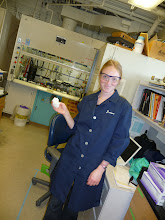
This work is licensed under a Creative Commons Attribution 2.0 Generic License.
The alkali metals are the metals in the first column on the left of the periodic table, including Lithium (Li), Sodium (Na), Potassium (K), Rubidium (Rb), Cesium (Cs), and Francium (Fr). They are notoriously "reactive" metals, forming metal hydroxides and hydrogen gas from water. In the case of the heavier alkali metals, this reaction can be QUITE exothermic! In the previous post on quenching a THF still, we saw how important it was to quench the remaining sodium very slowly and carefully with water. But Rubidium and Cesium are orders of magnitude more reactive with water than is sodium.
One commonality among the alkali metals is that they have one electron in the highest energy level, so they can lose that one electron to form an ionic bond with another element or group (typically an element or group that can easily gain one electron). For example, sodium metal and chlorine gas react to form sodium chloride (NaCl), which is used as "table salt," among other things. In fact, it is so useful that we have developed very effective ways of extracting it from salt rock (AKA "halite) all over the world. The picture above shows the Uyuni salt flats in Bolivia.
While sodium is an essential element in our diet in small amounts (e.g., we need it for the transmission of nerve impulses and for the contraction of muscles), it can be very harmful in large quantities. Too much sodium leads to increased blood pressure; increased blood pressure can lead to heart disease, stroke, etc. There are several sources of sodium in our diet, including processed foods (crackers, bread, baked goods, etc.), natural sources (milk, meats, fish, celery, etc.) and soy sauce. Sodium shows up in these foods not just in the form of NaCl but also as a component in several popular food additives/preservatives: Monosodium glutamate (MSG), baking soda (sodium bicarbonate, NaHCO3), disodium phosphate, sodium nitrate, sodium nitrite, and sodium alginate, just to name a few.
While some people choose to limit their sodium intake altogether and sacrifice the salty taste they know and love, others prefer to use so-called "salt substitutes," such as potassium chloride, which have a similar taste to sodium chloride, with the added advantage of being more heart-healthy. But at the end of the day, it doesn't matter so much which alkali metal salt you use to flavor your food, as how much of it you use. Moderation is the key to a long and healthy life!












